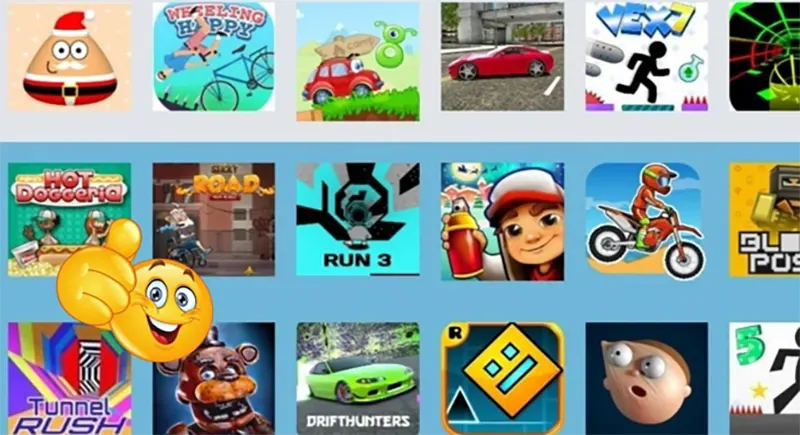In contemporary education, engaging students within the classroom is paramount for effective learning outcomes. Traditional methods of instruction often fall short in captivating learners’ attention, resulting in diminished motivation and lower retention rates. The integration of innovative strategies has become essential to create a more stimulating environment conducive to comprehension and participation.
Educational technology has emerged as a pivotal tool in addressing these challenges. Online games for classrooms represent a dynamic approach that harnesses interactive elements to enhance student engagement. These digital platforms not only foster an immersive learning experience but also promote key skills such as critical thinking, collaboration, and problem-solving. By incorporating online games into educational practices, educators can leverage technology to transform conventional teaching methodologies into engaging sessions that actively involve students. As we delve deeper into the top five online games that elevate learning while delivering enjoyment, insights will be provided that detail their functionalities and impact on student achievement.
Why Online Games are Effective Learning Tools
Online games for classrooms have gained recognition as a powerful medium to enhance student engagement. Interactive play allows students to immerse themselves in the learning process, fostering a more dynamic and participatory educational environment. For example, through quiz-based formats or gamified assessments, students can experience content retention that transcends traditional memorization methods. Such engagement is critical in capturing the attention of today’s digital-native learners, who may find conventional teaching methodologies less stimulating.
Moreover, online games promote teamwork skills and collaboration among peers. Many educational games are designed with cooperative mechanics that require players to work together towards common goals. For instance, in projects set within platforms like Minecraft: Education Edition, students must communicate effectively and strategize collectively to create complex structures or solve challenges within the game world. This collaborative approach not only strengthens interpersonal relations but also cultivates essential social skills that will benefit learners beyond the classroom setting.
Critical thinking and problem-solving skills are further developed through gameplay experiences offered by various online games. Problem-solving games often present scenarios that require analytical reasoning and creative solutions. As players encounter obstacles or puzzles—such as those featured in Low’s Adventure 2—they must assess situations critically and explore different pathways to progress through the game. This kind of interactive decision-making encourages learners to think independently while reinforcing their ability to tackle complex issues systematically.
In summary, the integration of online games into educational practices supports multiple facets of learner development including engagement, collaboration, and critical thinking. By leveraging these tools effectively within classroom settings, educators can provide immersive experiences that prepare students for future challenges in both academic and real-world contexts.
Game #1: Retro Bowl Unblocked 76
Retro Bowl Unblocked 76 is an interactive learning platform that employs a quiz-based format to engage students in a competitive environment. The game allows players to assume the role of a football coach, fostering strategic thinking as they navigate through diverse scenarios while answering questions from various subjects. This unique approach combines elements of sports with educational content, creating a dynamic atmosphere for knowledge retention. The incorporation of quizzes into gameplay encourages students to recall information and actively apply their learning, making it both enjoyable and informative.
The competitive nature of Retro Bowl enhances student engagement by fostering a sense of achievement among players. As they progress through the game by answering quiz questions correctly, students not only aim for high scores but also experience the thrill associated with victory in an engaging setting. Classroom activities can be tailored around this game, allowing for friendly competition that motivates students to learn while having fun. The blend of rivalry and collaboration found within the game contributes significantly to memory retention of the material covered during quizzes.
Additionally, Retro Bowl is designed for versatile integration across multiple subjects such as history, mathematics, science, and language arts. This adaptability allows educators to tailor content specifically aligned with their curricula, enhancing the overall classroom experience. For instance, a math-focused quiz may challenge students to solve equations that could affect their team’s strategy within the game context. Such flexibility ensures that teachers can continually refresh classroom activities while maintaining relevance with core educational objectives.
In summary, Retro Bowl Unblocked 76 exemplifies how interactive learning can effectively engage students and reinforce knowledge across various subjects. By utilizing competition as a driving force for enhancement in skills and understanding, educators are empowered to create meaningful experiences that resonate beyond traditional teaching methodologies.
Game #2: Minecraft: Education Edition
Minecraft: Education Edition serves as a profound example of how gamification in education can transform the learning experience. This online game for classrooms engages students by allowing them to participate in creative building and exploration within a virtual environment. In this immersive world, learners can construct complex structures, simulate real-world situations, and collaborate on projects that span various academic subjects. By stepping into a digital realm where imagination meets educational objectives, students are more likely to remain interested and motivated to learn.
The curriculum integration offered by Minecraft: Education Edition is extensive, encompassing topics such as coding, mathematics, and history. For instance, students can engage with basic programming concepts through the use of command blocks and redstone mechanisms while constructing functional farm systems or automated machines. Mathematics lessons are often illustrated through architectural design activities that require measurements and calculations for scale, thus contextualizing abstract concepts in an engaging manner. History lessons can be enhanced by recreating historical landmarks or events within the game environment, providing students with a tangible connection to the past.
Teamwork is another fundamental benefit embedded within Minecraft: Education Edition. Students frequently work collaboratively on projects that necessitate communication and collective problem-solving skills. For example, a group project may involve building a functioning ecosystem that incorporates elements from biology classes while demonstrating knowledge from environmental science. Such collaborative endeavors not only reinforce content mastery but also facilitate the development of essential social skills applicable both inside and outside the classroom.
In summary, Minecraft: Education Edition exemplifies effective digital learning tools that inherently encourage creativity while aligning closely with educational curricula. Its interactive nature provides participants with opportunities to delve deeper into academic subjects through experiential learning processes—ultimately enhancing engagement among students. As teachers integrate this platform into their instructional strategies, they empower learners to explore and innovate within a safe yet stimulating environment.
Game #3: Low’s Adventure 2
Low’s Adventure 2 is an innovative online game designed to transform the learning experience into a dynamic and engaging environment. Unlike traditional assessment methods, this platform incorporates gamified assessments that motivate students to participate actively in their education. Through interactive challenges and narrative-driven quests, learners are encouraged to engage with educational material in a playful context. This approach not only enhances student engagement but also makes complex concepts more accessible, thereby fostering a positive attitude towards learning.
One of the key features of Low’s Adventure 2 is its customizable content, which allows educators to align specific game elements with curriculum standards. Teachers can create tailored levels that address particular subjects or skills, ensuring relevance and applicability to their students’ academic requirements. This flexibility enables educators to adapt the game based on the varying needs of their classrooms, making it suitable for diverse learning styles and paces. For instance, subjects such as mathematics can be integrated seamlessly into gameplay through puzzles that challenge students’ problem-solving capabilities while reinforcing essential skills.
In addition to customization, Low’s Adventure 2 provides instant feedback mechanisms that allow students to assess their own understanding in real time. When a player succeeds or fails at a task within the game, immediate responses inform them about what they did correctly or areas needing improvement. This constructive feedback loop supports an effective learning process by helping students identify misconceptions promptly and facilitating guided learning paths that encourage mastery of new concepts. For remote learning scenarios, these instantaneous assessments serve as an invaluable tool for educators seeking insight into student performance without imposing additional burdens.
Overall, Low’s Adventure 2 exemplifies how fun educational games can bridge the gap between play and learning by integrating essential teaching concepts within an engaging framework. The combination of gamified assessments, customized content aligned with curricular standards, and instant feedback ensures that this online game effectively meets modern educational needs while providing enjoyment in the classroom setting or during remote learning sessions.
Game #4: Classcraft
Classcraft is an innovative online game that effectively transforms classroom management through the integration of gamification elements. In this system, students create their own avatars and participate in a collaborative adventure where their actions and behaviors directly impact their success. By incorporating game mechanics such as experience points (XP), health points (HP), and team objectives, educators can encourage positive behaviors while simultaneously managing classroom dynamics. This method not only creates a more engaging atmosphere but also fosters individual accountability amongst students.
An important aspect of Classcraft is its emphasis on enhancing social-emotional skills through character development. As students navigate challenges within the game, they are encouraged to reflect on cooperation, empathy, and conflict resolution—critical components for personal growth in any learning environment. For instance, if a student helps a teammate solve an academic challenge or supports them during gameplay conflicts, those actions may earn them additional rewards. This approach reinforces collaboration rather than competition among peers, thereby contributing to a more cohesive classroom community.
Furthermore, Classcraft’s immersive storytelling elements elevate the educational experience by creating a narrative around students’ learning journeys. The game’s plot develops alongside the progress made by the player-team combinations as they face various challenges tailored to curricular goals. By linking lessons with engaging narratives—such as embarking on quests related to history or science concepts—students can better grasp complex topics while being entertained. This technique not only maintains interest but also promotes retention of knowledge through contextualization within a story framework.
As one of the leading online games for classrooms today, Classcraft empowers educators to maintain engagement while effectively addressing both academic and developmental needs of students. By leveraging gamification strategies that encourage teamwork and emotional intelligence through interaction with avatars and narrative arcs, teachers can cultivate stronger student relationships and a more dynamic learning environment.
Game #5: Cookie Clicker 2
Cookie Clicker 2 serves as an interactive presentation platform that integrates quizzes and virtual reality components, revolutionizing the way students engage with educational content. This game enables educators to create immersive lessons where students can participate in real-time, fostering a dynamic learning environment. Through its intuitive design, Cookie Clicker 2 allows for seamless incorporation of various subject matter, transforming traditional lectures into interactive sessions that captivate student attention.
One of the defining features of Cookie Clicker 2 is its ability to facilitate active participation among all students. By incorporating quizzes during gameplay, teachers can assess understanding while maintaining engagement. For instance, a math teacher might design problems related to equations that unleash rewards or bonuses in the game when solved correctly. This method not only incentivizes knowledge retention but also promotes a competitive spirit among classmates, reinforcing concepts through playful collaboration.
Furthermore, Cookie Clicker 2 offers versatile applications across different subject areas. Educators utilizing this platform can tailor quizzes and challenges to fit subjects ranging from science to literature. A history lesson could involve earning points through answering questions about key events or figures correctly while navigating through a virtual historical landscape within the game. This adaptability enhances the overall educational experience by accommodating diverse learning styles and objectives relevant to multiple curricula.
In addition to enhancing subject comprehension, Cookie Clicker 2 also emphasizes critical thinking skills as students strategize their progress within the game mechanics. The continuous feedback provided through the game dynamics encourages learners to iterate on their approaches and improve performance over time. By employing such innovative tools like Cookie Clicker 2 in educational environments, educators are empowered to motivate their students effectively while promoting an engaging atmosphere of collective learning.
Tips for Implementing Online Games in the Classroom
The successful integration of online games into educational settings begins with aligning these digital tools with defined educational goals and curricula. Educators should identify the specific learning outcomes they aim to achieve, such as improving students’ math skills or enhancing critical thinking abilities. For instance, a game like Minecraft: Education Edition can be effectively utilized to teach geometry concepts. By selecting activities within the game that require measurement and spatial reasoning, educators can create a direct link between gameplay and academic objectives, thereby ensuring that the learning experience is both engaging and relevant.
Establishing ground rules is essential to maximize positive outcomes when using online games in classrooms. Clear guidelines help maintain focus on learning objectives while minimizing distractions during gameplay. For example, teachers might implement a policy where students must remain silent during independent gaming sessions but engage in discussion after completing certain tasks. This approach encourages students to take responsibility for their own learning while fostering an environment of respect during interactive play. Furthermore, setting limitations on screen time ensures that gaming remains a controlled part of the educational experience rather than overshadowing traditional instructional methods.
Encouraging feedback from students post-gameplay can significantly enhance the effectiveness of online games in classrooms. Gathering insights about what worked well and what did not can inform future lesson planning and game selection. An anonymous survey could be used to assess student engagement levels, concepts they found challenging, or features they enjoyed most about the game experience. Through this iterative feedback mechanism, educators can tailor subsequent sessions to better meet their students’ needs, thereby improving educational outcomes over time.
By implementing these strategies—aligning games with curricular goals, establishing clear ground rules, and encouraging ongoing student feedback—educators can optimize the use of online games for classrooms. This structured approach paves the way for enriching learning environments that embrace technology’s potential while remaining firmly focused on educational achievement.
Conclusion
The integration of online games into educational settings has been identified as a powerful method for enhancing student engagement and learning outcomes. These digital tools, such as retro bowl unblocked 76, Minecraft: Education Edition, Low’s Adventure 2, Classcraft, and Cookie Clicker 2, provide interactive environments that encourage collaboration, critical thinking, and problem-solving skills. Furthermore, by aligning these online games for classrooms with educational goals and curricula, significant improvements in knowledge retention and overall academic performance can be achieved.
Educators are encouraged to experiment with the implementation of these innovative tools in their teaching practices. By assessing student feedback and adjusting game parameters accordingly, personalized learning experiences can be developed that cater to diverse classroom needs. This proactive approach will foster immersive learning environments that not only motivate students but also promote essential skills in an increasingly digital world.








